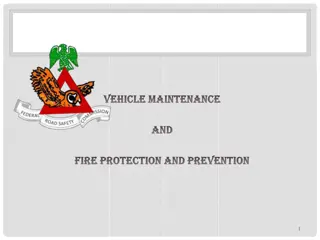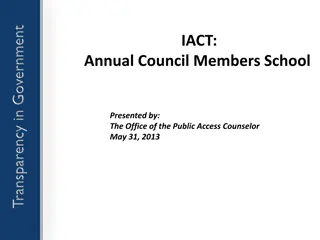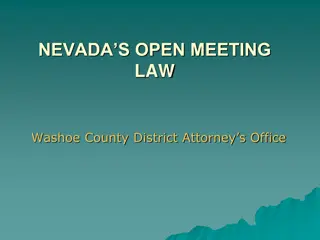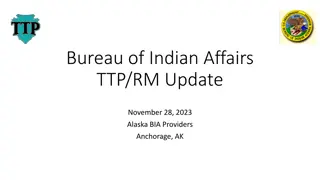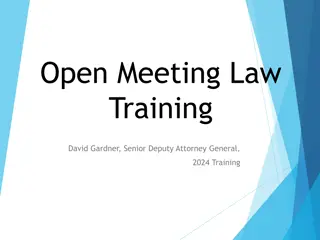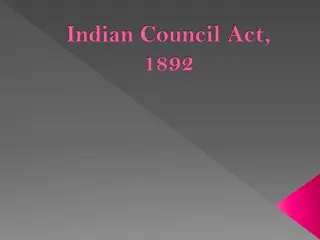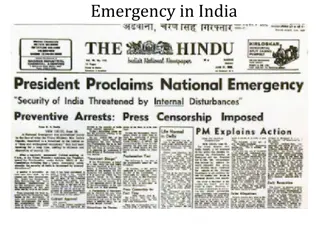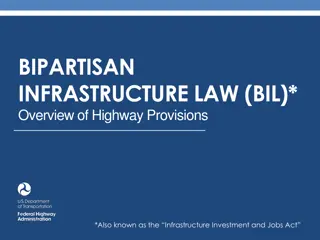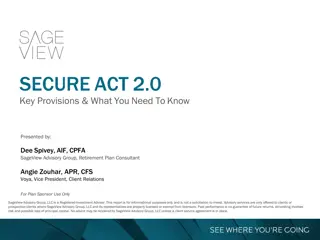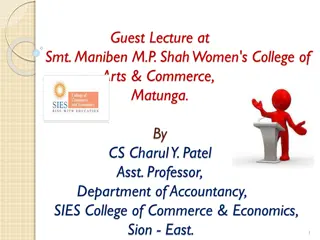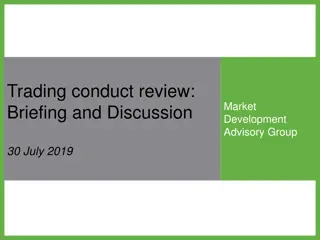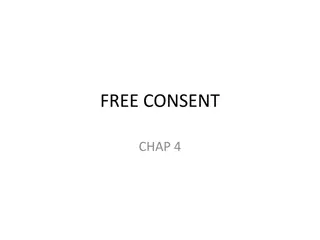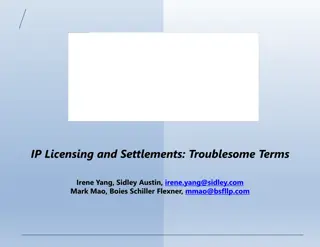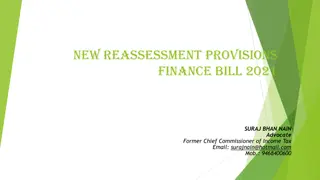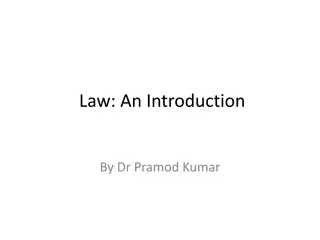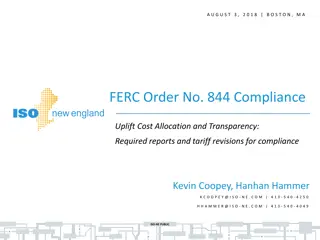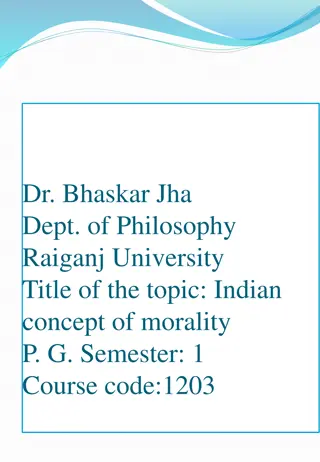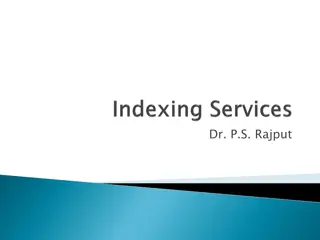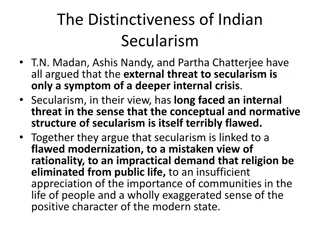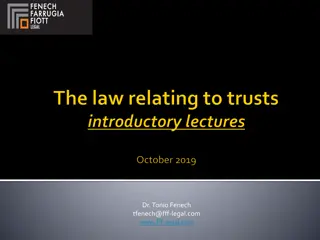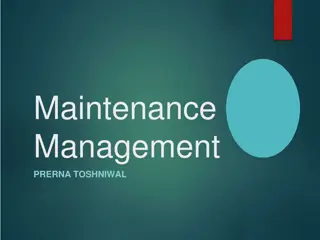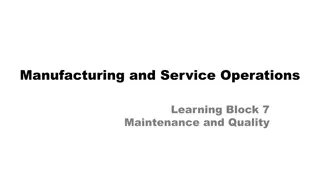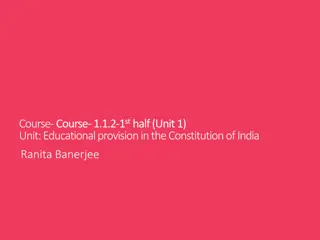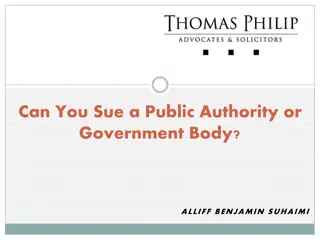Understanding Provisions for Public Order Maintenance in Indian Law
This article by Pankhuri Anand explores provisions in the Indian Penal Code and Code of Criminal Procedure for maintaining public order and tranquility. It discusses unlawful assembly, public nuisance, disputes, and their legal implications. Various sections and definitions are outlined to ensure peace in society.
Download Presentation

Please find below an Image/Link to download the presentation.
The content on the website is provided AS IS for your information and personal use only. It may not be sold, licensed, or shared on other websites without obtaining consent from the author. Download presentation by click this link. If you encounter any issues during the download, it is possible that the publisher has removed the file from their server.
E N D
Presentation Transcript
Maintenance of Public Order and Tranquility This article has been written by Pankhuri Anand , a student of Banasthali Vidyapith, Rajasthan. This article discusses all the provisions related to the maintenance of public order and tranquillity under the Indian Penal Code, 1860 and the Code of Criminal Procedure, 1973.
Maintenance of Public Order and Tranquility Public order and peace is something that should prevail in every civilised society. Peace and public order is essential for every civilised society and it is the duty of the state to maintain the Public Order and Tranquility. Several provisions have been laid down in the Indian Penal Code, The Code of Criminal Procedure and The Police Act for the maintenance of public order and tranquillity. Maintenance of Public Order and Tranquility has been dealt specifically under Chapter X of the Code of Criminal Procedure.
The public order is disturbed mainly due to: 1. Unlawful Assembly 2. Public Nuisance and Urgent Cases of Nuisance 3. Disputes related to immovable properties
Unlawful Assembly Unlawful assembly has been criminalised under the law to preserve public peace and security. The definition and punishments for unlawful assembly have been laid down under the Indian Penal Code which several other provisions have been laid down under the Code of Criminal Procedure as procedures to be followed in matters of unlawful assemblies. Section 141, 142 and 143 of the Indian Penal Code and section 129 to Section 132 of the Code of Criminal Procedure deals with the provisions for unlawful assemblies.
Provisions under the Indian Penal Code, 1860 Section 141:Definition of Unlawful Assembly For an assembly to be an unlawful assembly, these are the following requisites as laid down by section 141- 1. Assembly of Five or More Persons 2. Common Object
The assembly of five or more than five members having a common object should qualify at least one of the five acts mentioned under section 141 of the Indian Penal Code: 1. Use criminal force 2. Resists execution of law or legal process 3. Commit any mischief or criminal trespass or other offences 4. Taking or obtaining possession of any property by criminal force 5. Compel any person
Section 142: Being a member of unlawful assembly Whoever, having knowledge and being aware of the facts which tend any assembly as an unlawful assembly, intentionally joins that assembly, or continues being a member in it, is said to be a member of an unlawful assembly. Section 143: Punishment Section 143 of the Indian Penal Code states the punishment for being a member of an unlawful assembly. Being a member of unlawful assembly is punishable with: 1. Imprisonment of either description for a term extended upto six months, or, 2. Fine, or, 3. Both
Provisions under the Code of Criminal Procedure, 1973 Section 129 to Section 132 of Cr.P.C deals with the provisions for unlawful assemblies. Section 129 deals with Use of civil force for dispersal of assembly Section 130 deals with Use of armed forces to disperse assembly Section 131 deals with powers of certain armed force officers to disperse assembly Section 132 deals with Protection against prosecution for acts done under proceeding sections
Public Nuisances The term public nuisance has been defined under section 268 of Indian Penal Code. Section 133,134, 135, 136, 137, 138, 139, 140, 141, 142 and 143 deals with the procedures to be followed in matters related to public nuisance and the Urgent cases Nuisance or apprehended danger has been dealt under section 144.
Provisions under Cr.P.C Section 133: Conditional Order for removal of nuisance There are six categories of public nuisance which can be resolved under this section: 1. The unlawful obstruction or nuisance to any public place or to any way,river or channel lawfully used by the public; The conduct of any trade or occupation, or keeping of any goods or merchandise which is/can be injurious to health or physical comfort of community; The construction of any building , or disposal of any substance, as it is likely to occasion or explosion; A building, tent, or structure, or a tree as it likely to cause damage or injury to person; An unfenced tank, well or excavation near a public place or way; A dangerous animal that requires confinement, destruction or disposal. 2. 3. 4. 5. 6.
Section 134: Service or notification of order The order shall be served on the person against whom it is made in the manner which is followed for service of summons Section 135: Person to whom order is addressed to obey or show cause According to section 135, When an order is served against a person,he is left with two alternatives. He should have to either- 1. Carry out the order by performing in accordance with the directions given in the order or, 2. he may show cause against the order issued. Section 136:Consequences of failing to obey such order Penalty prescribed under section 188 of the Indian Penal Code i.e., Disobedience to order duly promulgated by public servant.
Section 137: Denial of Public Right Section 137 lays down the procedure where public rights are denied Section 138: Procedure when he appears to show cause If the magistrate is satisfied, the order shall be made absolute If the magistrate is not satisfied, no further proceedings shall not be taken in the case 1. 2. Section 139 of the Cr.P.C empowers the magistrate to direct local investigation for the purpose of inquiry under section 137 and 138. The power of magistrate regarding procedure and direction investigation has been given under section 140 of the Code of Criminal Procedure. Section 141 lays down procedure to be followed when order is made absolute and consequences of disobedience
Section 142: Power to issue injunction Where immediate measure is required to prevent any imminent danger or serious injury, injunction can be issued. Section 143 of the Code of Criminal Procedure empowers a District Magistrate or Sub- divisional Magistrate, or any other Executive Magistrate empowered by the State Government to prohibit repetition or connuence of public nuisance. Section 144: Order to be issued in urgent cases of nuisance or apprehended danger Section 144 comes into play when there are urgent cases of nuisance or apprehended danger. Order under this section can be passed and directions can be issued to prevent: Obstruction, damage or injury; Danger to human life, health or safety; Disturbance of the public tranquility Riot Affray
Nature of orders passed under section 144 1. Temporary order The order passed under section 144 is temporary in nature 1. Restrictive Order The order passed under section 144 is a restrictive order and not a mandatory order directing a person to do some act. Section 144A: Power of magistrate to prohibit carrying arms in procession The District Magistrate may prohibit carrying of arms in procession, or organising or practicing any mass drill with or without arms within his local jurisdiction
Disputes related to immovable property Section 145 to 148 of the Criminal Procedure deals with the procedures when there is likely to be a breach of peace and public order due to dispute relating to immovable property. Section 145: Breach of peace by dispute regarding land and water This section deals with the disputes regarding possession. The main objective of this section is to prevent any breach of public peace by maintaining possession of one or the other party which the court finds has the immediate possession before dispute unless the actual rights are decided by the civil court. Section 146: Attachment and appointment of receiver After making an order under section 145, the magistrate can anytime order under section 146 for attachment of the subject in dispute and appointment of receiver.
Section 147:Dispute regarding the right of use land or water Section 147 of Cr.P.C acts as an amplification of section 145. The right claimed against the matter in dispute under this section can be an easement or otherwise. Section 148- Provisions for local inquiry According to section 148, when under section 145, 146 or 147, necessity to conduct an inquiry is felt, a District Magistrate or Sub- divisional Magistrate may depute any subordinate magistrate to conduct an inquiry by issuing a written instruction.
CASES: 1.Iqbal and Anr. V. State of U.P, it was held by the Supreme Court that in the matter of unlawful assembly, common object must be present as one of the five essentials mentioned under section 141 of IPC. Common object can be gathered in such matters by the nature of assembly, arms used, behaviour of that assembly either during the act or prior the act. 2. Rakesh Kumar v. State of U.P[(1994) Cr. LJ All 289 ]. It was held that when a proceeding is instituted under section 133 of Cr.P.C, civil suit can continue parallely without any bar 3. Nagarjuna Paper Mills Ltd. v. S.D.M. & R.D. Officer, Sangareddy, [1987 Cr LJ 2071 (A.P)], the court held that Sub- Divisional Magistrate is empowered to pass order under section 136 of the code to close factory causing pollution as it failed to produce appreciation certificate from the Pollution Control Board. 4.in the case of Mani Mathai v. Uthuppu, [(1985) 2 Crimes 370 Ker.], it was held that on denial of public right, the magistrate shall conduct a preliminary inquiry. 5. In the case of Kushumkumaree Debee V. Hemalinee Debee [(1933) 63 Cal 11], it was held that the magistrate is only entitled to issue restrictive order under section 144, preventing a person from doing some act. He cannot make a mandatory order and issue directions to do some act. This section does not empowers magistrate to make a positive order.
CASES: 6. Ram Pal Singh v. Bhagelu [(1977) CrLJ 210], it was held that magistrate is not bound to pass preliminary order under section 145 if finds that there is no apprehension of breach of peace. 7. As held in the case of Lakhan Singh v. Kishun Singh [1970 CrLJ 1571], the principle of natural justice should be followed and the party should be given an opportunity to be heard before any adverse order is passed against it.
Conclusion Public Peace and security is necessary for every civilised society and it is the duty of State to maintain public order and tranquility. The provisions of the Indian Penal Code and the Code of Criminal Procedure maintain public order and tranquility. Indian Penal Code states provisions and punishment for acts which can be threat to public peace and security while the Code of Criminal Procedure states the procedure which needs to be followed by the state to maintain the public peace and tranquility. The procedures under chapter X of Cr.P.C are to be taken in urgent matters which are threat to public peace and security. Either the threat to public order is by unlawful assembly, public nuisance or due to dispute related to immovable property, Chapter X of Cr.P.C contains procedures to deal with such instances. lay down the provisions to


